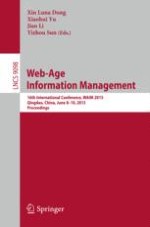This book constitutes the refereed proceedings of the 16th International Conference on Web-Age Information Management, WAIM 2015, held in Qingdao, China, in June 2015. The 33 full research papers, 31 short research papers, and 6 demonstrations were carefully reviewed and selected from 164 submissions. The focus of the conference is on following topics: advanced database and web applications, big data analytics big data management, caching and replication, cloud computing, content management, crowdsourcing data and information quality, data management for mobile and pervasive computing, data management on new hardware, data mining, data provenance and workflow, data warehousing and OLAP, deep web, digital libraries, entity resolution and entity linking and graph data management and RDF.
